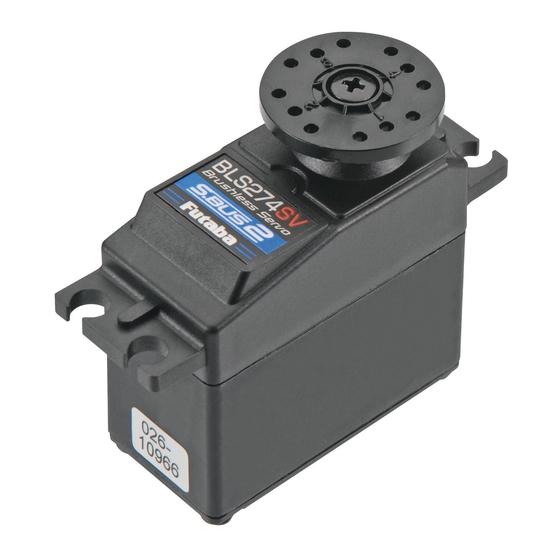
Advertisement
Quick Links
1M23N12738
WARNING
Since the S.BUS2 servo switches the operation mode au-
tomatically according to the type of signal (S.BUS signal/PWM signal) from the
receiver, if the connector is inserted or removed while the power is ON, an S.BUS
connected servo will be erroneously recognized and may stop.
the locked state (state in which enough force is applied that the servo cannot
have a waterproof construction. If it gets wet, the servo may not operate or the
power supply may short circuit.
amount of noise if touched. It will become impossible to receive and is extremely
dangerous.
in order to prevent excessive power consumption
and decrease the life of the motor and battery.
CAUTION
You may be burned because the motor and circuits inside the servo become
hot.
may be damaged.
construction. Futaba Corp. will not be responsible for any disassembly or modi-
It will damage with a shock.
be responsible if the servo is used in applications other than the above.
Futaba will not be responsible for damage, etc. caused by the use of
parts other than Genuine Futaba parts.
Using the S.BUS2 port an impressive array of telemetry sensors may
be utilized. This servo is connectable with the both sides of S.BUS and
S.BUS2 port.
servo
it can be used in
servo
it cannot be used in
S.BUS or S.BUS2
compatible
Ch output/
receiver
Battery terminal
S.BUS or S.BUS2 output
Battery
Conventional
servo
* Can also be used together with conventional servos.
* Items required: S.BUS or S.BUS2 receiver, S.BUS2 servo, S.BUS hub,
S.BUS channel setup compatible transmit-
S.BUS channel setting tool
ter / SBC-1 / CIU-2 / S.BUS channel setup compatible receiver
1. Set the channel at the S.BUS2 servos.
Set the channel at the S.BUS2 servos by using an S.BUS channel setting
tool.
* Refer to the S.BUS channel setting tool instruction manual for the S.BUS servo
channel setting method.
2. Connect the servos to an S.BUS or S.BUS2 compatible receiver.
Connect the servos from the S.BUS or S.BUS2 port of the S.BUS or S.BUS2
compatible receiver via S.BUS hubs.
Leaving the servo in
Reverse connection may cause
The servo does not
It will generate a large
The servo
The servo has a precision
Futaba will not
.
ID
ID
S.BUS hub
S.BUS hub
ID
ID
ID
S.BUS2 servo
• Current consumption
This servo is designed to be used with models which require especially high
eration. Therefore, decide the safe number of uses by paying careful attention
to the remaining battery capacity.
• Power supply
played with a dry cell battery.
Even if using a receiver with the BATTERY FAIL SAFE function, it may not op-
erate correctly. Therefore always check the battery voltage and charge the bat-
tery quickly.
When using 5 or more servos for large scale models, use a separate power
supply. An S
.BUS Hub with Cable (2-way/remote battery pack use)
can be utilized for using a separate power supply i
• System use
For full performance, 2.4GHz system is recommended.
• Programming function
This servo can be connected to a PC by using the CIU-2 USB Adapter sold
separately and its various operating characteristics can be changed as a pro-
grammable servo by means of dedicated software "S-Link". S-Link is down-
loadable from a Futaba WEB site. However, channel setting and other operat-
ing characteristics settings cannot be made with the existing S.BUS PCLink
software. When you use a transmitter with an S.BUS setting function. By con-
necting a servo to the S.BUS setting connector of the transmitter, a program
setup of a servo can be performed on the screen of a transmitter. This servo
does not have stop mode function. Therefore becomes as [ hold ] when the input
signal of a servo stops. Depending on a setup, a servo carries out vibration. If a
servo continues carrying out vibration, it will break, please restore a setup.
• Soft start
enters while the soft start is operating, it become normal operation at once.
[Servo Mounting Precautions]
Use attached dampers and eyelets correctly.
-
Screw
Rubber grommet
Eyelet
Servo mount
(Airplane)
Different from conventional radio control systems the S.BUS
system uses data communication to transmit control signals from
a receiver to a servo, gyro, or other S.BUS compatible device. This
.
data includes commands such as "move the channel 3 servo to
15 degrees, move the channel 5 servo to 30 degrees" to multiple
devices. The S.BUS devices execute only those commands for their
own set channel. For this reason, it can be used by connecting
multiple servos to the same signal line. Many S.BUS servos is
in the connected state, one servo of them can be set it up. The ID
code of each servo is used for it. ID code is indicated on the seal
of the case. After carrying in a model, it is convenient, if you use
attached ID seal and CH seal when ID cannot be seen.
Conventional
Receiver
Battery
* Operation is the same as that of a conventional servo.
An S.BUS2 servo connected to a conventional receiver operates as a
conventional servo. The channel becomes the receiver connection point.
*The contents set by programmable function are effective.
n the S.BUS system
Rubber grommet
Eyelet
Servo mount
Screw
(Helicopter)
Conventional
Servo
Ch output/
Battery terminal
S.BUS2 servo
S.BUS2 servo
-
-
sold separately
.
Advertisement

Summary of Contents for FUTABA HV BLS274SV
- Page 1 Eyelet Eyelet Servo mount Futaba will not be responsible for damage, etc. caused by the use of Servo mount Screw parts other than Genuine Futaba parts. (Airplane) (Helicopter) Using the S.BUS2 port an impressive array of telemetry sensors may...
- Page 2 Futaba �.susa Hi g h Volta ge Syst em BLS274SV BLS274SV 日白USHLESS コTOA ● SPEED ° at 6.6V 0.055 sec/60 ° 0.050 sec/60 at 7.4V ● TORQU E 4.4 kgf·cm at 6.6V (61.1 ozf·in at 6.6V) 5.0 kgf·cm at 7.4V (69.5 ozf·in at 7 .4V)









